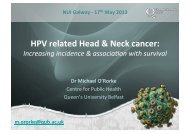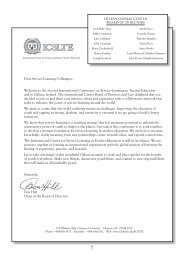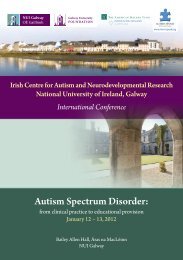Welcome to Galway Dr. Bob Kennedy Conference ... - Conference.ie
Welcome to Galway Dr. Bob Kennedy Conference ... - Conference.ie
Welcome to Galway Dr. Bob Kennedy Conference ... - Conference.ie
Create successful ePaper yourself
Turn your PDF publications into a flip-book with our unique Google optimized e-Paper software.
Theme: Biodiversity and ecosystem functionCan we discover Earth’s spec<strong>ie</strong>s before they go extinct?Mark J. CostelloInstitute of Marine Sc<strong>ie</strong>nce, Leigh Marine Labora<strong>to</strong>ry, University of Auckland,New Zealand.m.costello@auckland.ac.nzThe creation of global spec<strong>ie</strong>s inven<strong>to</strong>r<strong>ie</strong>s, such as the World Register ofMarine Spec<strong>ie</strong>s, provides a documented measure of how many spec<strong>ie</strong>sare known, who has named them, and their rate of description. Contrary<strong>to</strong> widespread bel<strong>ie</strong>f the number of people involved in naming spec<strong>ie</strong>s hasbeen increasing and has never been higher. The last decade saw a recordnumber of marine (but not non-marine) spec<strong>ie</strong>s named. The rate of discoveryof marine spec<strong>ie</strong>s has increased in recent decades, but not of terrestrialspec<strong>ie</strong>s (which account for about 75% of all named spec<strong>ie</strong>s). This knowledgehas enabled better estimates of how many marine spec<strong>ie</strong>s exist. We appear<strong>to</strong> be in a golden age of marine taxonomy, with about 2/3 of all spec<strong>ie</strong>s nowdiscovered.The evidence shows that there has been increased effort in discoveringspec<strong>ie</strong>s; e.g. that the greater number of authors per spec<strong>ie</strong>s named isnot due <strong>to</strong> proportionally more part-time taxonomists nor less specialists.Discover<strong>ie</strong>s of microbial diversity will not significantly alter the overall pattern.Microscopic spec<strong>ie</strong>s may have high local spec<strong>ie</strong>s richness and high geneticdiversity, but appear <strong>to</strong> have low global spec<strong>ie</strong>s richness. This reflects theirease of dispersal and high abundance, in contrast <strong>to</strong> the biogeograph<strong>ie</strong>s oflarger spec<strong>ie</strong>s. Thus most spec<strong>ie</strong>s have already been discovered. Tens ofthousands have been collected and await description.Estimates of spec<strong>ie</strong>s extinction rates are now more variable than estimates ofglobal spec<strong>ie</strong>s richness. Until recently, neither had accounted for the presenthigh taxonomic effort. Taken <strong>to</strong>gether, it is probable that most spec<strong>ie</strong>s willbe named this century and before they go extinct. This process of discoveryprovides a first step in documenting and understanding biodiversity, and thusaids conservation efforts.- 36 -









